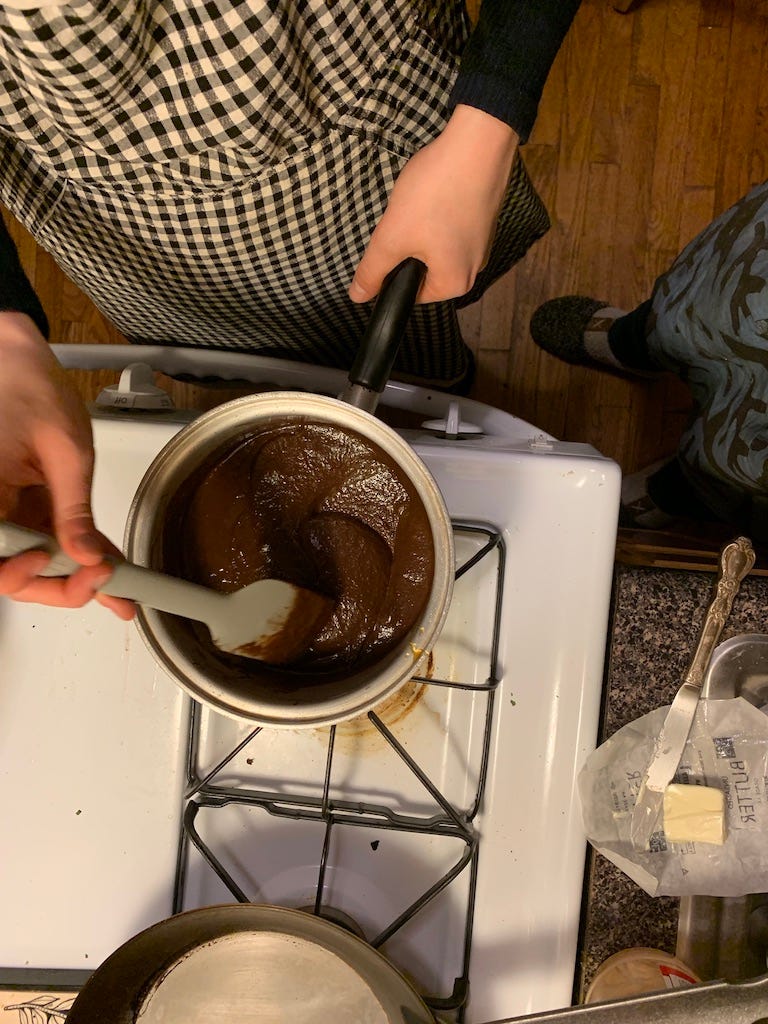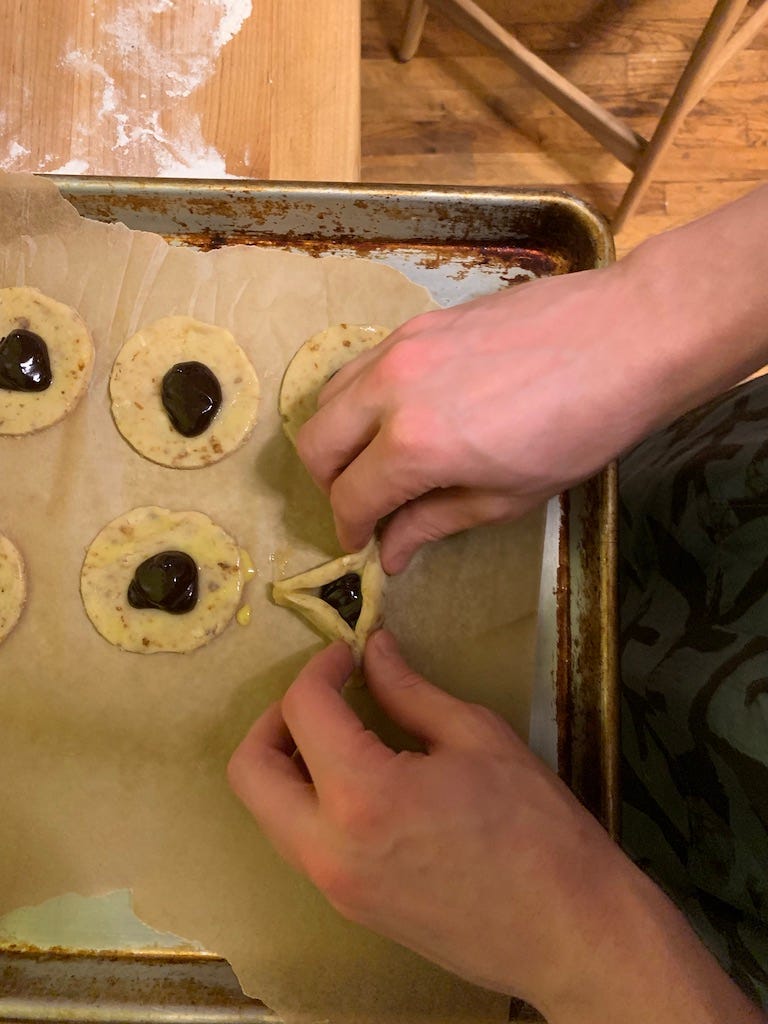For Vashti, who said no and was heard
It's Purim, so we've got nontraditional hamentaschen and some thoughts on Vashti
It's Purim (or it was when I wrote this) and I was reading about Purim, and thinking about Queen Vashti, and Esther.

For the uninitiated: Vashti was the queen who had to be deposed for Esther to save the Jewish people, it is Esther's victory of convincing her dumb husband (I don’t remember his name, nor do I think it is important) not to listen to Haman and put to death the Jews of, like, Babylon that is celebrated at Purim. Vashti was deposed because she didn't dance naked for her husband's friends. Esther persuaded her stupid husband not to commit genocide by getting him to love her, and then telling him that she's Jewish and doesn't want to die. (This is a gross simplification, but you get the general idea. You can read about it other places.)
There are, of course, a number of articles debating the villainy or strength of Vashti (was she actually just vain?), and the weakness, or resilience, of Esther (was she too traditionally feminine?). I'm no scholar of the Torah, I don't have a lot to contribute to this fight. You can read about it elsewhere, but suffice to say: feminist interpretation has painted both of them both poorly and well. I have been to Purim celebrations where we cheer when we speak of Vashti, and have been to other gatherings where she's a mere afterthought.
This year I have been unable to stop thinking about Vashti
Vashti was the beautiful (this is important) first wife of some Babylonian king whose name does not, I think, matter. What is significant about Vashti (for Purim) is that she was the wife who had to be removed so that Esther could do her duty (namely, saving the Jewish people).
Vashti was deposed (and perhaps deheaded) because she refused to do as her husband bade her. She refused, for whatever reason, to dance naked before her drunk husband and his drunk friends.
Vashti is honored by feminist Jews for being the woman who said no. Vashti’s story is told so briefly in the book of Esther and she only is there to refuse. This has made her a hero, for so many who have longed to have their refusals recognized.
The Babylonian Rabbis wrote that Vashti was wicked, cruel, and vain. They said that Vashti’s “no” didn’t signify, because it had been preceded by a yes. Vashti had danced for her husbands friends before, and the reason why she refused was not modesty, but rather because she had a rash. Now, as we are all thinking feeling humans we know that this is not how consent works.
No, the troubling thing that the Babylonian rabbis said about Vashti was that she hated Jews, and forced Jewish women to work naked, humiliating them for her own pleasure. The rabbinate asks us, “what sort of heroine is this?” She does not compare to Esther, Esther who the feminists have rejected!
And of course, if this were true, it would make it pretty hard for Vashti to be an icon. But I wonder, why do we think that this might be true? I mean, the rabbis have said it, but why? What is the purpose of diminishing Vashti? Esther became queen, she saved the Jewish people, and Vashti? Well, nobody knows. Some say that after her disobedience Vashti was executed. Others have said that she was banished. Vashti was happily forgotten, left to molder in the first chapter of Esther, but the rabbis of Babylon felt a need, for some reason, to discredit her.
If Vashti had been deposed for something less sympathetic, would the men in power still have felt compelled to make her an enemy to Jewish women? If Vashti has been deposed because she had danced, would the Babylonian rabbis have treated that as enough? Could they tell, even then, that their wives chafed against the dictate that each man was king of his own home?
I know nothing of Vashti, none of us do. All I have to offer is this: if Vashti had not been in danger of becoming a hero, I do not believe they would have bothered with making her a villain.

What I’m reading this week
The world’s greatest art thief
“Compost” Hamentaschen with caramel chocolate filling
Recipe from The Nosher
Filling loosely adapted from ReformJudaism.com and David Leibowitz

For the dough:
1 cup butter (or margarine)
1 1/4 cup sugar
2 tsp vanilla
2 Tbsp milk or almond milk
2 eggs
1/2 tsp salt
1/2 tsp baking powder
2 1/2 cups unbleached all-purpose flour
2 Tbsp crushed potato chips
2 Tbsp crushed cornflakes
1 Tbsp coffee grounds (I used two tsp instant espresso)
Filling:
4 ounces bittersweet or semisweet chocolate
2 oz unsweetened chocolate
1/2 cup sugar
3 tablespoons butter
1 teaspoon vanilla
1 tsp instant espresso (optional)
1 egg
1-2 tbs flour (start with less, go up as needed)
A good pinch of salt
Directions
In a stand mixer fitted with paddle attachment, beat butter until creamy. Scrape down sides of bowl and add sugar. Beat again until light and fluffy.
Add egg, vanilla and milk. Scrape down sides again.
In a separate bowl, whisk together flour, salt, baking powder, crushed cornflakes and crushed potato chips. (I crushed mine very fine, per instructions, but wish I had left them bigger, for more crunch. You do you!)
Add dry ingredients to wet ingredients until dough comes together.
Scrape dough from bowl and form into two rounds. Wrap in plastic wrap and chill for 1 hour or up to 24 hours.
Make the filling:
Get out a heavy bottomed sauce pan, melt sugar over medium heat until it is dark brown and smoking (for a lighter caramel, idk, take it off earlier? You don’t want it to burn, but it’s just something you get a feel for.) As soon as it looks right, throw in the butter, stir vigorously. Once the butter is melted, add all the chocolate, stirring until melted. Give it a few minutes to cool.
My filling became grainy because there was a drop of water in the caramel.

Unintuitively, the solution to this, should it afflict you, is 1. Don’t panic, and 2. Put it back on the heat, adding water a tablespoon at a time, while stirring, until it becomes smooth. This took about 3 tablespoons of water for us.
Once it is smooth, add in the instant espresso, if you’re using it, and the vanilla. Test for heat. If it feels like it wouldn’t scramble an egg, add in the egg. There is no need to beat the egg before hand, just mix it thoroughly. Add the flour. It should look like a loose pudding. It will puff up and get body in the oven (thank you egg) but it should not be super runny. If it seems too liquid add another tablespoon of flour. Set aside to use as filling.

Making the Hamentaschen
Preheat oven to 400 degrees.
When ready to bake, roll out dough onto lightly floured surface until 1/4 inch thick. Cut dough into rounds and fill. Use less filling than you think is appropriate. I used a 2 ½ inch cookie cutter, and something like a teaspoon or less of filling. I did not measure the filling, and actually I found the easiest way to fill my taschen was to use a pastry bag, but you could use a ziplock if you want. It’s less messy.
Pinch up circle into triangles and pinch very tight. (Noah notes: the seams will split, so you don’t want to be able to see the seams) Place on baking sheet lined with a silpat or parchment paper and pop in freezer for 10 minutes.
Bake for 7-9 minutes. Allow to cool completely.
A few notes:
The recipe says the dough only lasts for 24 hours. I made my dough Sunday, and Noah baked some of it on Wednesday. It was definitely better when baked Sunday, much puffier. But the cookies baked Wednesday were still good, just thinner. The filling, however, was just as good baked Wednesday as it was Sunday. If you put it in the refrigerator you can scoop it into cookies using a teaspoon, which could make the filling and cookie making process easier. Just something to consider!


